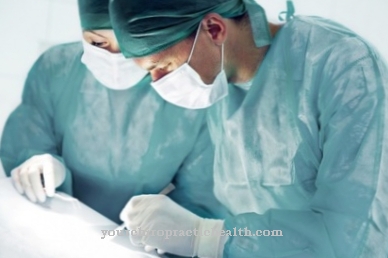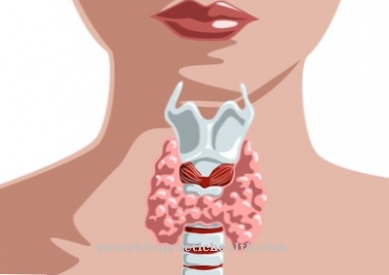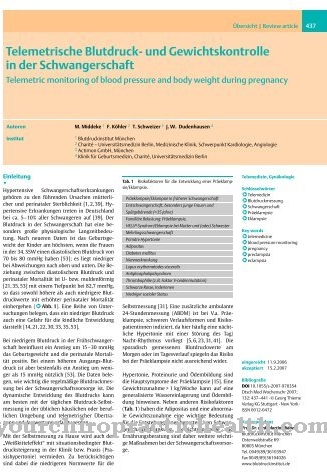The Stereo microscope is a light microscope that works with separate beam inputs and in this way creates a spatial impression in the sense of three-dimensionality. Stereo microscopes correspond to either the Greenough or the Abbe type, although there are also some special forms. In applied medicine, the devices are used in modifications as slit lamps and colposcopes.
What is a stereo microscope?

Light microscopes display high magnifications of small structures and objects by taking advantage of optical effects. The stereo microscope is a light microscope that provides a separate beam path for both eyes. For this reason, when looking through the stereomicroscope, the eyes see the specimen from different angles. This creates a kind of stereo effect that creates a spatial impression.
The stereo microscope is often used Binocular called. In the real sense, however, it is to be distinguished from both binoculars and stereo loupes. Unlike magnifying glasses, the stereomicroscope has a magnification in two stages, which are provided by means of an objective and an eyepiece.
The stereomicroscope is also to be distinguished from the binocular microscope, which corresponds to the conventional light microscope and works with two ocular views. Unlike the stereo microscope, this light microscope works with just a single image of the specimen, which the integrated beam splitter on the eyepiece provides for both eyes. Despite the first appearance, no 3D effects in the sense of additional image information are generated.
The microscope must also be differentiated from the Leica / Wild Heerbrugg macroscope, which looks similar to the stereo microscope but corresponds to a reflected light photomicroscope. There are different forms of the stereo microscope. The most famous microscope of this type is the Greenough type microscope, which was invented by Horatio S. Greenough in the 19th century.
Shapes, types & types
The Greenough-type stereo microscope works with two completely separate beam paths. Two lenses in a common mount create the stereo angle. The optical axes of the lenses are inclined to each other by a few degrees. This type of stereo microscope creates an ideal image quality at a comparatively low price. However, additional devices for microphotography or drawing tubes are difficult to attach.
For this reason, the second type of stereo microscope, the Abbe-type microscope, has since become more popular. The Abbe-Ty corresponds to a type of telescope that was invented by Ernst Abbe. The double lens of the stereoscopy is missing in this model. It is replaced by a common main lens with a large diameter. The diaphragms behind the lens only use the edge rays at an angle of 11 ° to create the image and thus create the stereo angle. There is a tube lens in front of the eyepiece. An integrated roller in the telescope system allows the user to easily adjust the magnification.
In addition to these two main types, the stereo microscope has several special forms. One example is the stereo microscope base, which corresponds to a small stereo microscope stand with an optics carrier. In addition to the main lens, the optics carrier has a prism system that enables the spatial separation of the incoming rays. Pocket binoculars sit on top of the device. This type of microscope produces constant magnification of 12, 16 or 20 times.
Structure & functionality
Stereo microscopes are used in teaching, research and technology. Biology, medicine and dental technology offer the technology a particularly wide range of applications. The devices are used in these areas, for example, for preparative work or are used on ultramicrotomes. In medicine, the stereomicroscope is mainly used in a modified form and in this context corresponds to a colposcope. Slit lamp microscopes are also used in ophthalmology.
The surgical microscopes used in surgery are more powerful than the stereo microscope and only reproduce a reduced stereo effect. In the broadest sense, however, they can also be described as modifications of the stereomicroscope.
In addition to the medical field, stereomicroscopes are used in geology, paleontology, for material examinations or in mineralogy. The devices also play a role in criminology and help with restoration work in the arts.
All stereo microscopes have a similar technique. Unlike the binocular microscope, they use two separate beam paths through which the observer sees the object from different angles, usually with differences in direction of 11 ° to 16 °. This creates a spatial impression. The stereo angle generated in this way is based on the angle of convergence of the two eyes during near accommodation. Often a double iris diaphragm sits in the tube beam path and increases the depth of field.
Medical & health benefits
The stereomicroscope has a high medical and biological benefit. This benefit has proven itself at the latest with Hand Spemann's Nobel Prize in the Biology category, which he received for work on developmental physiology. The research would not have been possible without stereomicroscopy. In 1935, Spemann had documented the organizing effect within embryonic development and had proven through transplantation experiments that the tissues behave with site-specificity.
Apart from medical research, the stereomicroscope in modified forms is partly also relevant in applied medicine, especially as a colposcope, slit lamp microscope and surgical microscope. In gynecological colposcopy, critical changes in the area of the cervix and the cervical mucosa, such as small tissue defects, tumors and microhemorrhages, can be detected as part of the preventive examination.
Ophthalmological slit lamps, on the other hand, can document the anterior, middle and posterior sections of the eye up to the retinal periphery using different exposure methods and light slit widths. Surgical microscopes are also standard in medicine these days and have almost completely replaced surgical loupes. Compared to loupes, they offer higher magnification, quieter operating fields and significantly better illumination.















.jpg)











